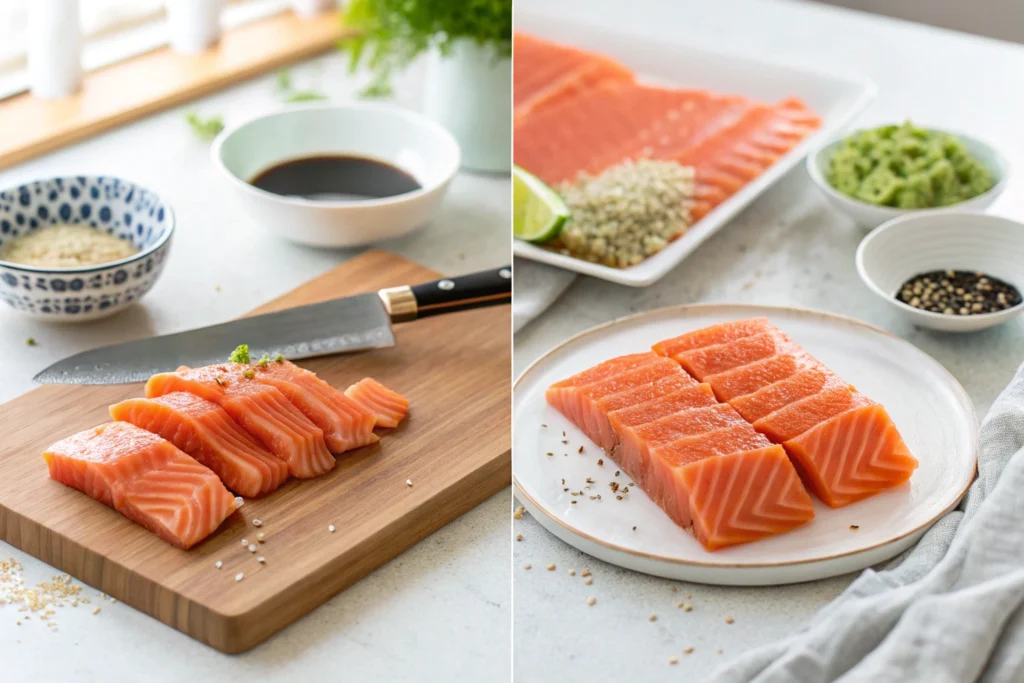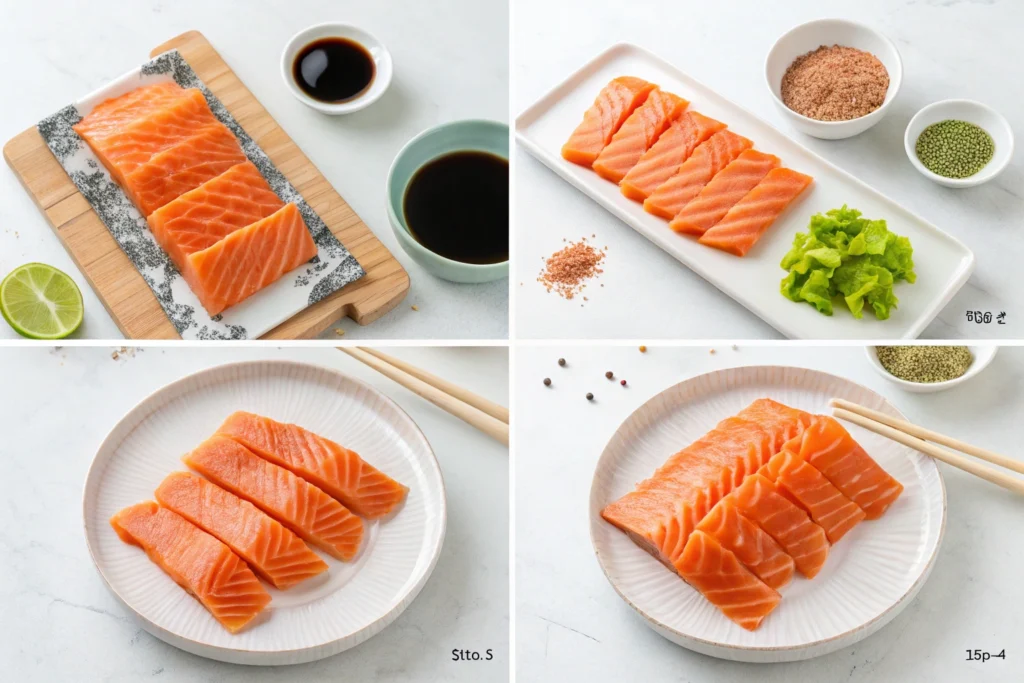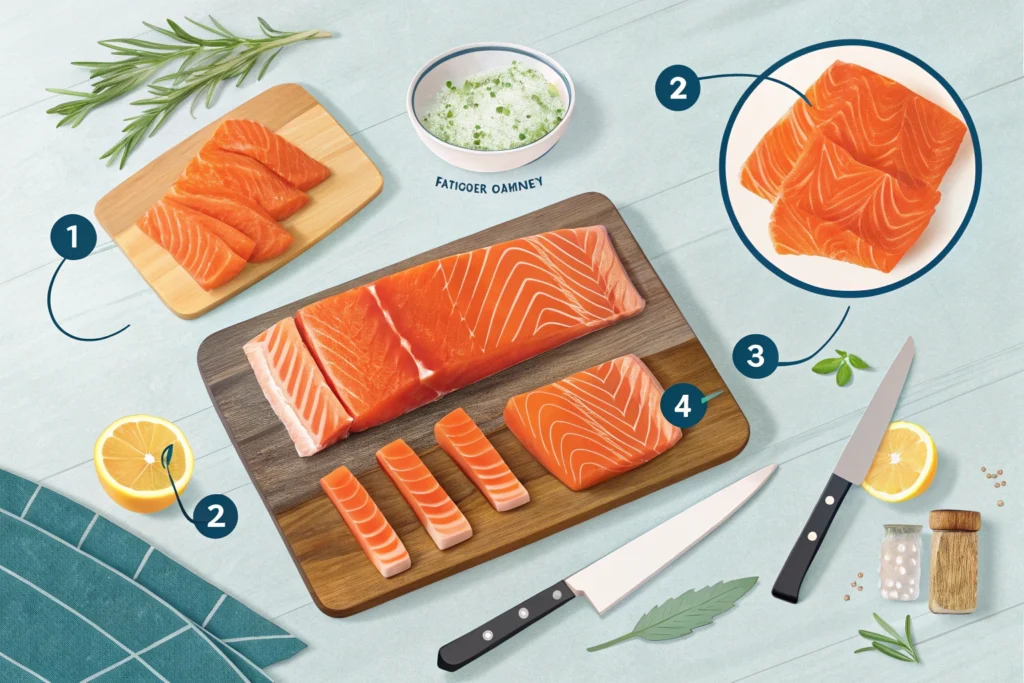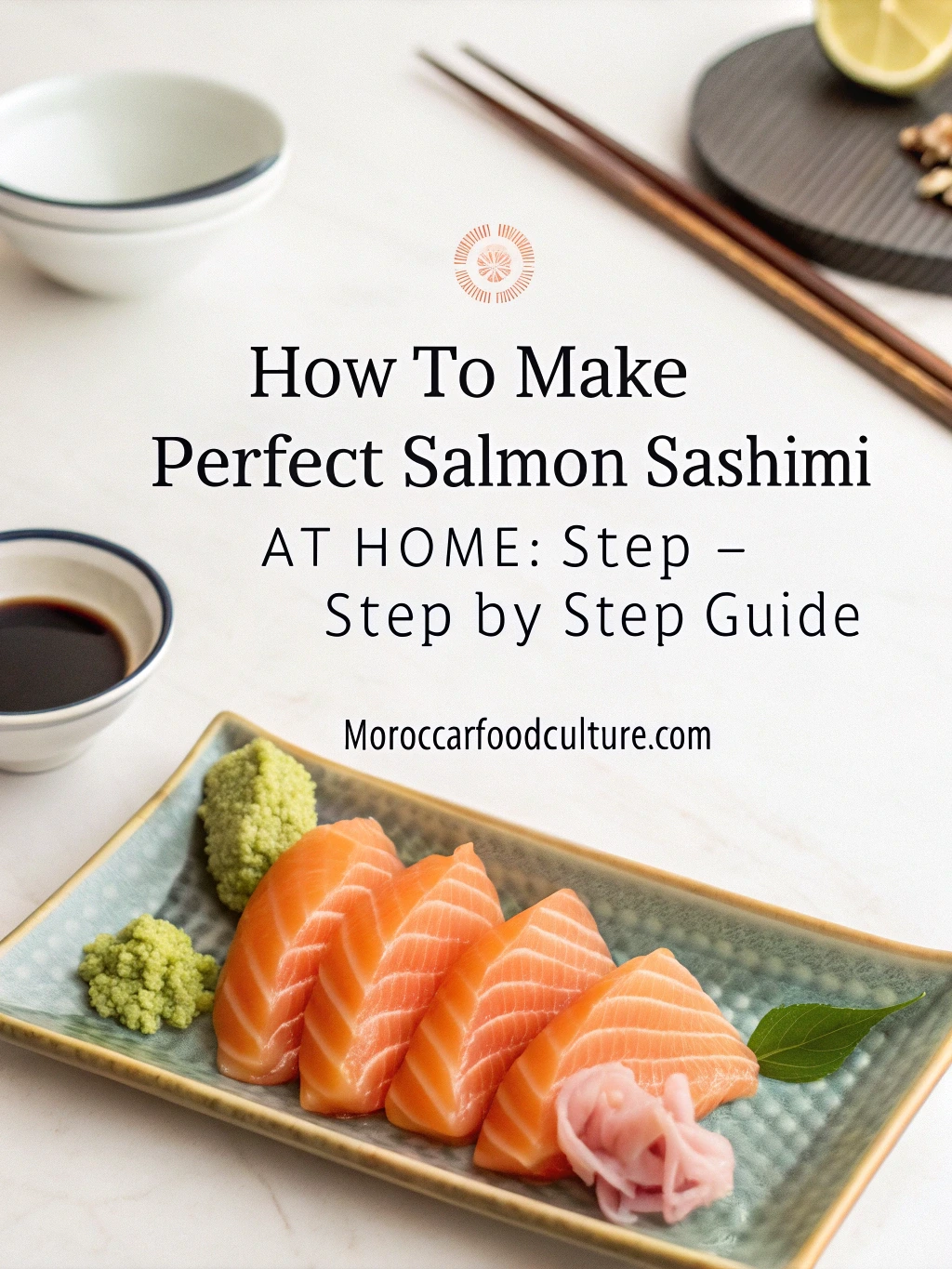How to Make Perfect Salmon Sashimi at Home: The Ultimate Step-by-Step Guide
That first encounter with perfectly prepared salmon sashimi creates an unforgettable sensory experience. The coral-pink slices gleam under restaurant lighting, their silky texture yielding to the gentlest pressure of chopsticks. The clean, fresh flavor bursts across your palate – delicate yet distinct, with that characteristic rich mouthfeel that only pristine raw salmon can deliver.
For many culinary enthusiasts, salmon sashimi represents the epitome of Japanese cuisine’s philosophy: simplicity that highlights exceptional ingredients rather than masking them with complex techniques. Yet this apparent simplicity can feel intimidating. How could something so elemental be recreated outside professional kitchens?
The truth might surprise you. With proper guidance, suitable tools, and most importantly, access to appropriate fish, you can craft restaurant-quality salmon sashimi in your own home. This comprehensive guide will walk you through each crucial step, from selecting perfect sashimi-grade salmon to presenting your finished creation with professional flair.
Table of Contents

Understanding Sashimi-Grade Salmon
Before wielding any knife, you must understand what makes salmon suitable for raw consumption. This knowledge forms the foundation of safe, delicious sashimi preparation.
Sushi-Grade vs. Regular Salmon
The term “sushi-grade” or “sashimi-grade” doesn’t reflect official FDA terminology but rather indicates fish prepared according to specific standards for raw consumption. Quality sashimi-grade salmon undergoes flash-freezing at temperatures of at least -31°F (-35°C) to eliminate potential parasites, particularly Anisakis, which can cause foodborne illness.
This deep-freezing process must occur either immediately upon harvest (on fishing vessels) or shortly thereafter in processing facilities. Beyond safety concerns, proper flash-freezing preserves the salmon’s texture and flavor while extending its viability for raw consumption.
Regular supermarket salmon typically hasn’t undergone this specific handling protocol and therefore presents both safety risks and inferior texture when consumed raw. Never substitute standard salmon for sashimi-grade fish.
Where to Buy Sashimi-Grade Salmon
Finding proper sashimi-grade salmon requires knowing where to look:
- Japanese markets and specialty fish retailers: Dedicated seafood stores often maintain separate sushi-grade sections with appropriate handling practices
- Premium grocers: Retailers like Whole Foods typically offer properly designated sushi-grade options with trained staff
- Online seafood specialists: Several reputable companies ship flash-frozen sashimi-grade fish with dry ice, maintaining proper temperature during transit
- Local fishmongers: Especially in coastal areas, established local fish markets may carry or special-order suitable salmon upon request
What to Look For When Buying
When selecting salmon for sashimi, evaluate these critical quality indicators:
- Color: Premium salmon displays vibrant coral-orange hues with minimal white striations (albino muscle tissue)
- Aroma: Fresh sashimi-grade salmon emits only a mild, clean ocean scent – never a strong “fishy” smell that indicates deterioration
- Texture: The flesh should feel firm to gentle pressure, springing back without leaving indentations
- Surface: Look for glossy, moist flesh without dry patches or discoloration
- Clarification: Confirm explicitly with the seller that the salmon meets standards for raw consumption
Essential Tools and Ingredients
Creating exceptional salmon sashimi requires proper equipment and accompaniments. Investing in appropriate tools elevates both the preparation process and final result.
Tools You’ll Need
| Tool | Purpose | Recommendation |
|---|---|---|
| Sashimi knife (yanagiba) | Creates clean, precise cuts without crushing cells | 8-10″ blade, single-beveled edge |
| Cutting board | Provides stable, hygienic cutting surface | Composite wood or polyethylene, non-porous |
| Kitchen scale | Ensures consistent portion sizes | Digital for precise measurements |
| Kitchen shears | Facilitates skin removal | Stainless steel, easy to sanitize |
| Fine-tipped tweezers | Extracts pin bones without damaging flesh | Stainless steel, 5-6″ length |
| Ice bath setup | Maintains optimal temperature | Large bowl with smaller nested bowl |
While traditional yanagiba knives deliver superior results through their specialized design, any extremely sharp knife with sufficient length can serve adequately. The key lies in maintaining exceptional sharpness through proper honing and sharpening procedures.
Ingredients Checklist
Beyond the salmon itself, prepare these traditional accompaniments:
- 1 pound sashimi-grade salmon (yields approximately 4 servings)
- Premium Japanese soy sauce (avoid mass-market varieties with excessive additives)
- Genuine wasabi paste or freshly grated wasabi root (not horseradish-based imitations)
- Pickled ginger (gari) for palate cleansing
- Fresh daikon radish for garnish and textural contrast
- Thinly sliced scallions for aromatic elements
- Toasted sesame seeds for subtle nutty notes
- Optional: ponzu sauce for citrus-enhanced flavor profiles
Step-by-Step Salmon Sashimi Preparation
Creating perfect salmon sashimi requires methodical preparation and precise technique. Following these steps ensures both safety and exceptional quality.
Preparation (Day Before)
Proper planning starts well before slicing:
- Purchase sashimi-grade salmon from a reputable source
- Store in the coldest section of your refrigerator (32-34°F)
- Prepare your workspace by gathering all necessary tools
- Ensure cutting surfaces and implements are thoroughly sanitized
Safety Precautions
Workspace Sanitation
Raw fish demands impeccable hygiene practices:
- Disinfect all food-contact surfaces with appropriate sanitizing solutions
- Wash hands thoroughly with antibacterial soap before handling fish
- Use dedicated cutting boards exclusively for raw seafood preparation
- Maintain cool ambient temperature during preparation when possible
Temperature Control
Temperature management represents a critical safety factor:
- Keep salmon refrigerated until immediately before preparation
- Work efficiently to minimize time at room temperature
- Consider using an ice bath beneath your cutting board for extended preparation sessions
- Return unused portions to refrigeration immediately after cutting
Step 1: Preparing the Salmon Fillet
Begin with careful preliminary preparation:
- Remove salmon from refrigeration
- Briefly rinse under cold running water to remove any surface debris
- Pat thoroughly dry with paper towels to improve knife control
- Inspect carefully for remaining pin bones, removing any discovered with tweezers
- Position fillet skin-side down on cutting board if still attached
Step 2: Removing the Skin
Proper skin removal requires careful technique:
- Grasp the tail end firmly with your non-dominant hand
- Insert a sharp knife between skin and flesh at approximately a 30-degree angle
- Using gentle sawing motions, work forward while pulling skin taut away from blade
- Maintain consistent angle to maximize flesh retention
- Set skin aside for alternative uses (crispy salmon skin makes excellent garnishes)
Step 3: Trimming the Fillet
Refining your salmon ensures pristine flavor and appearance:
- Locate and remove the darker red bloodline tissue that runs through center
- Trim away any silvery membranes or connective tissue with precision
- Square off irregular edges to create geometric uniformity
- Reserve trimmings for cooked applications like salmon tartare or fried rice

Step 4: Slicing Perfect Salmon Sashimi
The cutting technique fundamentally influences texture and presentation:
- Chill knife blade in ice water, then thoroughly dry before cutting
- Position trimmed fillet with muscle grain running horizontally
- For optimal tenderness, cut perpendicular to the grain (across muscle fibers)
- For traditional sashimi preparation:
- Hold knife at approximately 45-degree angle to cutting board
- Slice with single, fluid pulling motion rather than sawing
- Aim for consistent thickness of approximately 1/4 inch (0.5-0.7cm)
- Wipe blade clean between cuts to maintain precision
- For thinner usuzukuri-style slices:
- Reduce blade angle to 10-15 degrees relative to board
- Execute longer, more deliberate pulling strokes
- Produce nearly translucent slices that showcase light transmission
Presentation Techniques
In Japanese culinary tradition, visual presentation holds equal importance to flavor. Thoughtful arrangement transforms simple sliced fish into an artistic expression.
Classic Arrangement Styles
Consider these traditional presentation approaches:
- Sugata-zukuri: Create an elegant fan shape by slightly overlapping slices in curved formation
- Hira-zukuri: Arrange rectangular slices in neat, parallel rows for minimalist elegance
- Usuzukuri: Overlap extremely thin slices in circular patterns resembling flower petals
Garnishes and Accompaniments
Thoughtful garnishes enhance both visual appeal and flavor complexity:
- Carve daikon radish into thin sheets for traditional white backdrop
- Position vibrant shiso leaves for striking color contrast
- Incorporate delicate microgreens for contemporary presentation
- Create cucumber ribbons using vegetable peeler for refreshing textural element
- Arrange small wasabi mounds and pickled ginger strategically across plate
- Add thin citrus wheels or supremes for acidic brightness
Sauce Presentation
Different serving vessels influence the dining experience:
| Sauce | Serving Style | Flavor Profile |
|---|---|---|
| Premium Soy Sauce | Small shallow dish | Umami-rich, delicate saltiness |
| Ponzu | Pour-spout cruet or small dish | Bright citrus notes, lighter body |
| Yuzu Kosho | Ceramic spoon or plate edge | Intense citrus-chili heat |
| Wasabi-Infused Soy | Premixed in shallow dish | Complex, nasal-clearing intensity |
Complementary Flavors and Pairings
While purists appreciate sashimi’s unadorned simplicity, thoughtful accompaniments can create memorable flavor combinations.
Traditional Accompaniments
Classic Japanese pairings have endured for centuries:
- Freshly grated wasabi root (true wasabi, not colored horseradish)
- Thinly sliced pickled ginger for palate cleansing
- High-quality Japanese soy sauce (shoyu) or wheat-free tamari
- Finely grated daikon with soy for dipping
Creative Flavor Combinations
Contemporary interpretations introduce new dimensions:
- Citrus Infusion
- Paper-thin lemon or lime slices underneath salmon
- Light drizzle of yuzu juice across slices
- Microplaned orange or yuzu zest as aromatic garnish
- Savory Enhancement
- Few drops of toasted sesame oil alongside traditional soy
- Finely sliced scallion greens scattered across plate
- Light sprinkle of toasted sesame seeds for textural contrast
- Elevated Heat Elements
- Thinly sliced jalapeño or serrano peppers (seeds removed)
- Tiny dots of quality sriracha on plate edges
- Light dusting of togarashi (Japanese seven-spice blend)
Serving and Consumption Tips
Proper service enhances the sashimi experience through temperature management and presentation timing.
Temperature Considerations
Temperature profoundly influences salmon’s flavor profile:
Sashimi tastes best when served cool but not refrigerator-cold. Remove portioned salmon 5-10 minutes before serving to allow subtle warming that enhances flavor molecule volatility. This brief tempering period awakens dormant flavors while maintaining food safety.
Proper Eating Etiquette
Traditional consumption follows certain guidelines:
- Either chopsticks or clean fingers remain acceptable for handling sashimi
- When using soy sauce, dip fish side (rather than rice side when serving nigiri)
- Consume pieces in single bites when size permits for optimal flavor experience
- Use pickled ginger between different fish varieties or flavor profiles as palate refresher
Sake and Beverage Pairings
Thoughtful beverage selection enhances the dining experience:
| Beverage | Style | Pairing Notes |
|---|---|---|
| Premium Sake | Junmai Daiginjo | Delicate, floral notes complement salmon’s richness |
| White Wine | Unoaked Chardonnay or Albariño | Crisp acidity balances fatty richness |
| Craft Beer | Japanese-Style Lager | Light, refreshing counterpoint |
| Traditional Tea | High-Quality Sencha | Grassy notes cleanse palate between bites |
Common Challenges and Solutions
Even experienced home chefs encounter occasional difficulties. Understanding typical problems ensures consistent results.
Troubleshooting Guide
Address these common challenges with practical solutions:
- Problem: Uneven or ragged slice edges Solution: Ensure knife maintains exceptional sharpness; execute cuts with single fluid motion rather than sawing
- Problem: Noticeable fishy aroma Solution: Return salmon to vendor immediately; quality sashimi-grade fish never exhibits pronounced fishiness
- Problem: Difficulty achieving thin, consistent slices Solution: Partially freeze salmon for 20-30 minutes before slicing to firm texture; ensure knife remains extremely sharp
- Problem: Fish sticking to knife blade during cutting Solution: Clean and dry blade between cuts; maintain light water film on blade surface
Storing Leftover Sashimi-Grade Salmon
While immediate consumption delivers optimal experience, proper storage preserves quality:
- Store unsliced portions tightly wrapped in plastic film, then aluminum foil to prevent oxidation
- Maintain coldest refrigerator temperature (32-34°F) in dedicated seafood drawer
- For extended freshness, place wrapped salmon on ice bowl in refrigerator
- Consume within 24 hours maximum; never refreeze previously thawed sashimi-grade fish

Conclusion: Your Journey to Sashimi Mastery
Creating perfect salmon sashimi at home represents both technical skill development and artistic expression. Through careful ingredient sourcing, proper tool selection, and practiced technique, you can craft sashimi rivaling professional establishments. Each preparation session builds confidence and refines your personal approach.
Begin with these foundational techniques, then gradually introduce creative variations reflecting your evolving preferences. Soon you’ll discover the profound satisfaction that comes from transforming premium ingredients into exquisite culinary experiences through seemingly simple but precisely executed techniques.
The journey toward sashimi mastery exemplifies the Japanese concept of kaizen – continuous improvement through deliberate practice. Each slice brings you closer to perfection, with every meal becoming both nourishment and artistic expression.
Frequently Asked Questions About Salmon Sashimi
Is it safe to make salmon sashimi at home?
Yes, preparing salmon sashimi at home remains completely safe when using properly sourced sashimi-grade salmon that has undergone commercial freezing according to FDA guidelines. Always purchase from reputable vendors who specifically designate their products as suitable for raw consumption.
Can I use any salmon to make sashimi?
No, only use specifically designated sashimi-grade or sushi-grade salmon for raw preparation. Standard grocery store salmon hasn’t undergone proper parasitic elimination procedures and shouldn’t be consumed without cooking to appropriate temperatures.
How long does salmon sashimi stay fresh?
For optimal flavor and safety, consume salmon sashimi immediately after preparation. Unsliced sashimi-grade salmon can be stored properly wrapped in the coldest part of your refrigerator for up to 24 hours, though quality diminishes progressively after purchase.
What’s the difference between salmon sashimi and salmon nigiri?
Salmon sashimi consists exclusively of sliced raw salmon served without rice, while salmon nigiri features raw salmon draped over seasoned sushi rice. Both showcase raw salmon but differ in composition and eating experience.
Can pregnant women eat salmon sashimi?
Medical professionals generally advise pregnant women to avoid all raw fish consumption, including salmon sashimi, due to potential foodborne illness risks that could affect maternal and fetal health. Always consult your healthcare provider for personalized guidance regarding dietary restrictions during pregnancy.
What knife is best for cutting salmon sashimi?
Traditional Japanese yanagiba knives, with their single-beveled edge design, create clean slices that preserve cellular integrity. However, any extremely sharp knife with sufficient blade length can produce excellent results when properly maintained and skillfully handled.
How thick should salmon sashimi slices be?
Traditional salmon sashimi typically measures approximately 1/4 inch (0.5-0.7cm) thick, though thickness variations accommodate different serving styles. Thinner usuzukuri-style slices highlight translucent delicacy, while standard hira-zukuri cuts emphasize salmon’s luxurious texture.
Have you given our recipe a try?
There are no reviews yet. Be the first one to write one.






